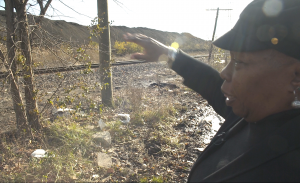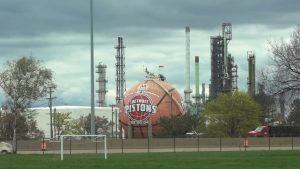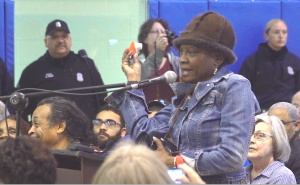
The Sierra Club’s Rhonda Anderson drives down Jefferson Avenue across the city line where Detroit turns into River Rouge. “This area has always been identified as the Tri-Cities,” Anderson said as quickly enough she crossed the border again into the city of Ecorse. “If there’s a family in either one of these cities, nine times out of ten they have an uncle or a cousin or somebody in the other city.”

Rhonda Anderson of the Sierra Club, courtesy of Bill Kubota
Anderson pulls up by a railroad crossing and points to what look like some gigantic anthills obscured by leafless trees. “You see them?” Anderson says, now out of the car and walking down the tracks. “You see how far back they’re going?”
The dark gray piles look like dirt, extending in a long row for blocks along the other side of the tracks running parallel to the Detroit River.
Anderson’s concern is about the fugitive dust and the local air quality. When the wind picks up, the material in those piles that look to be thirty feet high can blow into the neighborhood, onto homes and cars, and maybe into peoples’ lungs.
And what are those piles made of?
Anderson didn’t know. Nor did two of the residents who lived nearby. She’d later learn from the Michigan Department of Environmental Quality that the piles consisted of slag, a byproduct of steelmaking, which makes sense since there’s a steel mill nearby. It’s the same place Anderson’s father worked for thirty years, dying two years after he retired. She thinks the pollution here helped led to his early demise.

Southwest Detroit neighborhood, courtesy of Bill Kubota
The Tri-Cities are surrounded by industry. Along with the steel mills, there is a coal burning electric power plant, the region’s wastewater treatment plant and in the city of Detroit proper, an oil refinery. This very southernmost tip of Detroit is called 48217, the most polluted zip code in the state.
The Michigan Department of Environmental Quality (MDEQ) has determined this an area of ‘non-attainment’ for sulfur dioxide where air monitoring readings show the air quality is below the federal standard.
The refinery had requested permission to add more sulfur dioxide to the air. At a town hall meeting in Southwest last year, Detroit Mayor Mike Duggan pointed to a small red spot on an otherwise white map of Michigan. “If you can’t see it,” Duggan said, “it’s right down here. It’s the area where we’re sitting.”

Marathon Petroleum Refinery, courtesy of Bill Kubota
The Marathon Petroleum refinery operation wanted to add more sulfur dioxide to the air over 48217, asking for a pollution trade-off because it would be making a new, cleaner burning gasoline. There would be less sulfur from the vehicles burning it across the region, but 48217 would get an additional 22 tons a year of sulfur dioxide, a compound linked to asthma and other respiratory ailments.
Marathon spokesman Jim Wilkins told the crowd the number wouldn’t actually be that high. “To be honest, we feel that the 22 tons really isn’t real,” Wilkins said. “At the end of the day when this is up and running, the actual emission increase will be closer to ten tons per year.”
Duggan came out opposing the request, adding, “If the permit is approved, I will promise you, we will be in federal court. You cannot raise the pollutant levels on the poor area of the city, the most polluted, to benefit everybody else.”

Emma Lockridge Michigan United Organizer, courtesy of Bill Kubota
Duggan’s speech came as a surprise of some residents like Emma Lockridge, who lives just a few blocks from the refinery. She said, “I’d like to thank the mayor for finally standing up for us. We really need that.”
Lockridge grew up in the house her parents bought in the mid-1950s. She moved back a few years ago to help her mother. “I was startled at how it smelled in here,” she said, “because at night I couldn’t breathe. It was the chemicals in the air.”
Now she says she’s been stricken with asthma, lymphoma and kidney failure.
Lockridge has become an organizer for Michigan United, a coalition of progressive community groups statewide, while her photography documenting her environment has been shown in exhibitions focusing on environmental justice.
“People would say, like, ‘they were there first, why don’t you just move?’” Lockridge said, “Well the fact is my parents bought this house before Marathon purchased that small little oil company over there.”
In real estate, it’s all about location. Lockridge said back in the 1980s her home could have sold for $80,000. Now, she said it’s worth $12,000, so little she can’t afford to move.
A few months after the hearing the MDEQ allowed Marathon a new permit, but Marathon agreed not to emit any additional sulfur dioxide, even reducing the amount by one ton a year.
The decision was seen as a win for the residents.
A few more positive developments from the residents’ perspective have come since then, including a recent federal court ruling that a class-action lawsuit could continue for those in one neighborhood next to the refinery seeking compensation from the oil company.
Also, an ordinance regulating fugitive dust recently passed on a vote of seven to two by Detroit City Council after years of deliberations.
The ordinance would require some dust-causing substances like petcoke be completely covered.
Those opposed to the ordinance say it’s too costly for business and that it’s redundant because there are already state laws in place to help keep the dust down.
48217 resident Theresa Landrum has been working on environmental issues for years, learning the ins and outs of environment law while working with Marathon and other industrial operations, along with state and federal agencies to reduce pollution in her neighborhood.
“It takes a long while,” she says. “These are small victories. We’re making some inroads and we’re beginning to have a voice.”
Earlier this year, One Detroit reported on how residents in 48217 worked with the Michigan Department of Environmental Quality to install their own air monitoring station. Click here to see more on that story.




